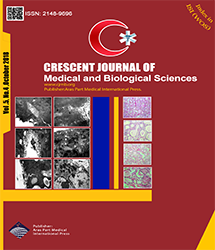
| Original Article | |
| Impact of Clinical Mat Pilates on Body Composition and Functional Indices in Female Patients With Multiple Sclerosis | |
| Elham Eftekhari1,2, Masoud Etemadifar3,4 | |
| 1Department of Physical Education and Sport Sciences, Najafabad Branch, Islamic Azad University, Najafabad, Iran 2Sport Medicine Research Center, Najafabad Branch, Islamic Azad University, Najafabad, Iran 3Department of Neurology, School of Medicine, Isfahan University of Medical Sciences, Isfahan, Iran 4Isfahan Neurosurgery Research Center, School of Medicine, Isfahan University of Medical Sciences, Isfahan, Iran |
|
|
CJMB 2018; 5: 297–305 Viewed : 5681 times Downloaded : 3542 times. Keywords : Body composition, Fatigue, Functional indices, Multiple sclerosis, Pilates |
|
| Full Text(PDF) | Related Articles | |
| Abstract | |
Objectives: Muscle weakness, movement disorders and fatigue due to multiple sclerosis (MS) cause a decrease in balance and physical activity, which may be linked to the body composition. The purpose of our study was to investigate the effect of clinical mat Pilates on anthropometric variables, functional indices, and fatigue in females suffering from MS. Materials and Methods: There were 30 female MS patients with mild to moderate disability, based on the McDonald criteria. They were randomly divided into 2 Pilates training (PT) and control (C) groups of equal size. The PT group followed the protocol of training 3d/wk for 8 weeks. The control group continued their routine life. Pre- and post-test of the variables in all the participants were done by one of the authors, who was blind to the groups. The anthropometric variables such as body weight (BW), body mass index (BMI), body circumferences (waist [WC], Hip [HC], mid-arm muscle [MAMC], and calf [CC]), waist to hip ratio (WHR), 7-site skinfold (chest, abdominal, thigh, triceps, subscapular, suprailiac, and midaxillary), fat percentage (FP), fat mass (FM), fat free mass (FFM), and body density (BD), functional indices consisting of balance, walking speed, endurance, and fatigue were accessed. Results: Statistical analysis demonstrated a significant decrease in BW, BMI, WC, HC, MAMC, skin-folds of the chest, abdominal, triceps, suprailiac, FP, FM and fatigue and also increase in BD, balance, walking speed, and endurance in Pilates group (P < 0.05). Conclusions: An 8-week mat Pilates program as non-pharmacological intervention may positively affect anthropometric variables, Functional indices and fatigue which may decline some of the outcomes of muscle weakness as one of MS complications. |
Cite By, Google Scholar
Online Submission System
 CJMB ENDNOTE ® Style
CJMB ENDNOTE ® Style
 Tutorials
Tutorials
 Publication Charge
Medical and Biological Research Center
About Journal
Publication Charge
Medical and Biological Research Center
About Journal
Aras Part Medical International Press Editor-in-Chief
Arash Khaki
Deputy Editor
Zafer Akan


















